This blog post and the research it summarizes was authored by Andrew Camp, Gema Zamarro & Josh McGee.
This summer, teachers across Arkansas will take a much-needed break to recharge after another difficult year. Since the start of the COVID-19 pandemic, educators have faced the unprecedented and unexpected challenges of remote learning, preventing the spread of COVID-19, and dealing with students’ absences due to quarantines and illness.
Throughout these unusual times, teachers have reported much higher levels of stress and a higher proportion of teachers report that they have considered leaving the profession. The increased stress that the pandemic has put on school personnel has sparked fears about a potential exodus of teachers and an increase in teacher shortages. Teachers are among the largest school-based contributors to students’ academic success and turnover is both costly for districts and harmful to students’ academic progress. As students face unprecedented learning losses, an increase in teacher turnover might also seriously hinder attempts at recovery.
In our prior research, we found that teachers were more likely to report that they have considered leaving their position or retiring if they are approaching retirement age, had to change instructional modes during the academic year, have higher COVID-19-related health concerns, or report high levels of job-related burnout. However, teachers who consider leaving may not ultimately leave.
So, are teachers leaving the classroom more than before the pandemic?
In our new report, we explore changes in Arkansan teachers’ mobility and attrition two years into the COVID-19 pandemic. Arkansas is an especially interesting context as districts in the state were required to offer in-person learning five days per week.
Like similar analyses from Washington and Massachusetts, we find stable turnover rates during the first year of the pandemic (2020-2021) but a 2.2 percentage point increase in teacher mobility and attrition in the second year (2021-2022).
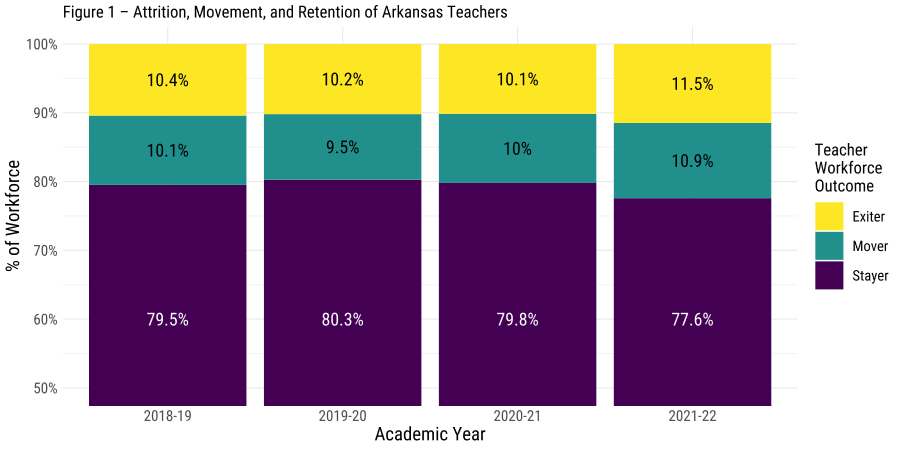
Turnover, which we define as a teacher either moving schools or exiting the Arkansas teacher workforce entirely, did not change uniformly across the state. While all regions experienced increased turnover entering the pandemic’s second academic year (2021-22). Northwest, Southeast, and Southwest Arkansas saw the highest increases in teacher turnover. This is especially worrisome for districts in the Southeast and Southwest as many districts already experienced teacher shortages before the pandemic and tend to serve students from higher-poverty backgrounds. We also observed increased turnover due to transfers across schools in Northwest Arkansas during the first pandemic academic year.
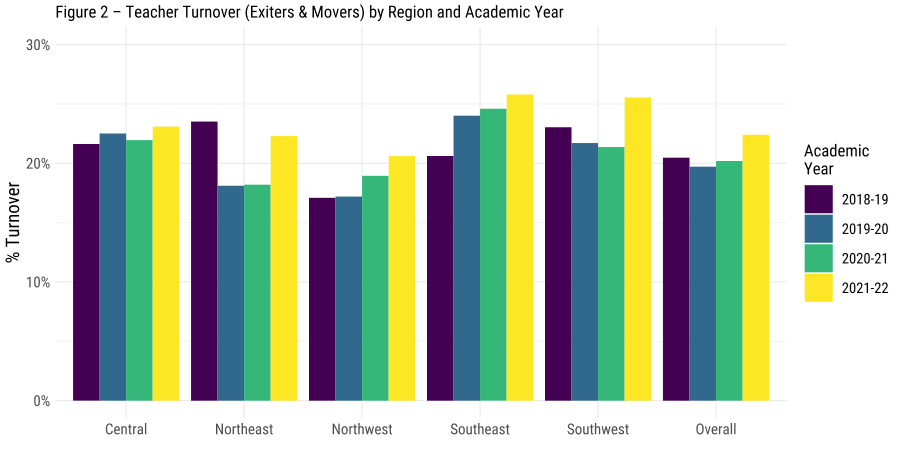
Our prior research found that teachers approaching retirement age (55 or older) were more likely to report having considered leaving or retiring in a national survey from March 2021. When examining Arkansas, we find that the proportion of these teachers exiting the Arkansas teacher workforce increased by about 2 percentage points entering the 2020-21 academic year. Increased turnover among the most experienced teachers could have important consequences for Arkansas’s teacher quality, which may in turn impact student academic outcomes during the pandemic recovery.
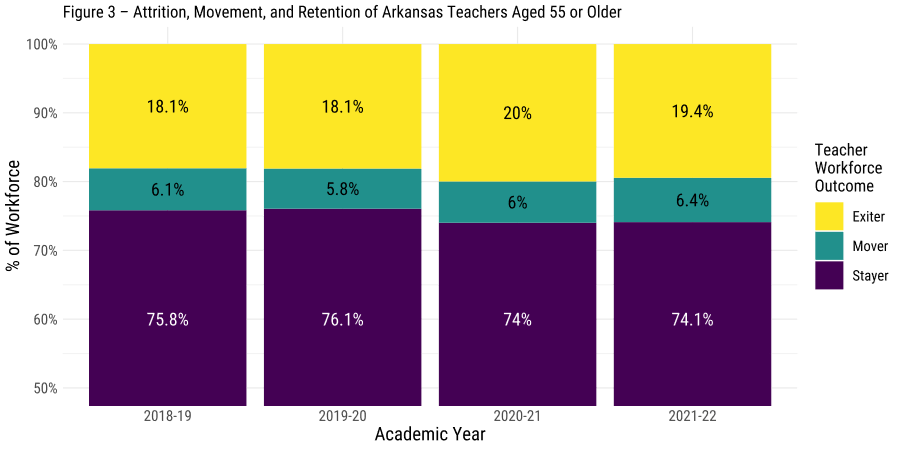
We also study the retention and attrition patterns of beginning teachers who started their careers during the pandemic and likely envisioned a very different experience. While the proportion of these beginning teachers who exit the profession did not increase during the pandemic, we do observe a nearly 5 percentage point increase in the proportion of new teachers who move across schools or districts entering the 2021-22 academic year.
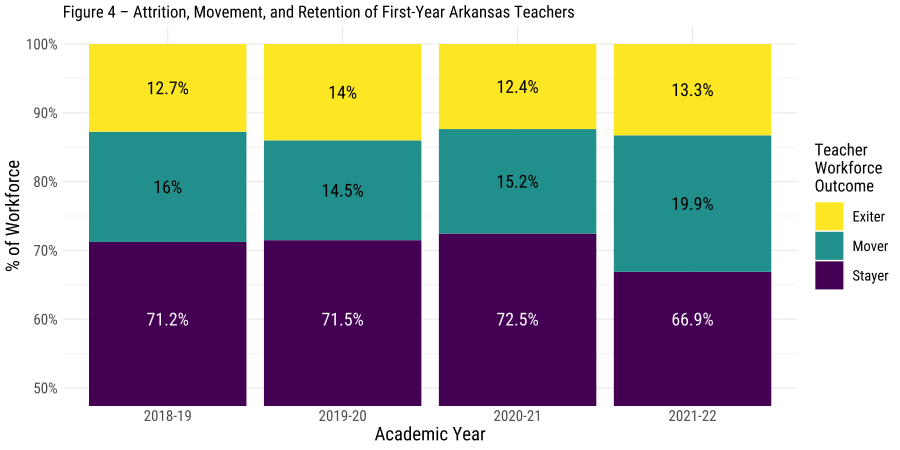
Increasing the diversity of the Arkansas teacher labor force is of great concern given the documented benefits that prior research has shown for racially minoritized students. For this reason, we also examine the retention of Black teachers during the pandemic.
Before the pandemic, the retention rate for Black teachers was 5 percentage points lower than teachers overall, although the gap between white and Black teachers was statistically insignificant once we controlled for teacher and school characteristics. During the pandemic, however, this gap has dramatically increased, with a larger number of Black teachers now exiting the Arkansas teacher workforce.
We observe that during the pandemic retention of Black teachers in the same school decreased from about 75% in pre-pandemic academic years to 71% in the first pandemic year and 68% in the second pandemic year. This is in contrast with overall retention rates of about 80% pre-pandemic and during the first pandemic academic year and 78% during the second year of the pandemic. That represents a difference in retention rates for Black teachers of 10 percentage points in the second year of the pandemic.
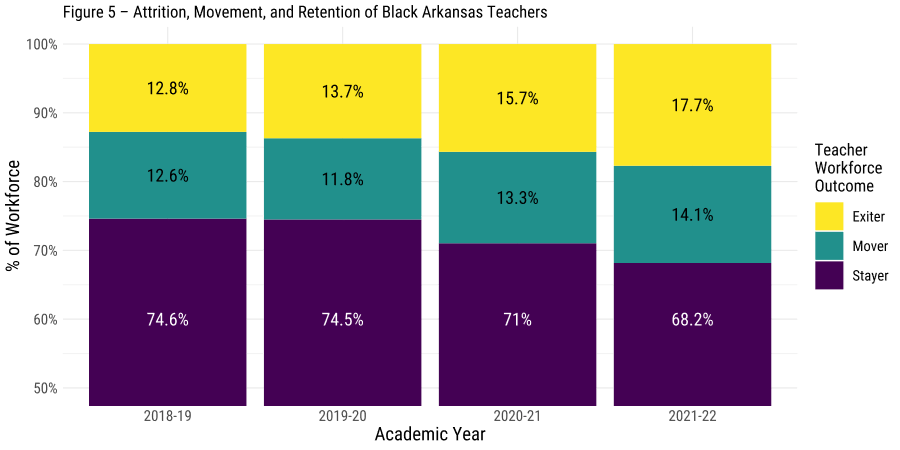
We further analyze changes in teacher retention and exits using statistical logit and multinomial logit models. These models, which allow us to control for multiple factors and compare similar teachers who teach at comparable schools, confirm that as the pandemic has progressed, Black teachers have become more likely to exit the profession compared to white teachers. Black teachers became 3 percentage points less likely to remain in the same school than white teachers in the first pandemic year and 4 percentage points less likely in the second year. These results raise serious concerns about a potential reduction in the diversity of the Arkansas teacher labor force.
Our statistical models also reveal other changes in retention during COVID. Before the pandemic, teachers in more disadvantaged schools were retained less than teachers in advantaged schools. Compared to a school where none of the students qualify for the Free or Reduced-priced Lunch Program (FRL), a school where 50 percent of the students qualify can expect about a one percentage point decrease in the probability of teachers remaining at that school in the subsequent year. During the pandemic, however, this relationship has nearly tripled in magnitude. Now, a fifty-percentage point increase in the proportion of FRL students at a school corresponds to a 2.5-3 percentage point decrease in retention.
Finally, and in line with our prior research, having to change learning modes during the school year was associated with about a 4-percentage point reduction in teacher retention. This reduction seems to be evenly driven by teachers transferring to another school or exiting the Arkansas teacher workforce altogether.
What does this mean for Arkansas teachers, schools, and students?
The COVID-19 pandemic has been a challenging time for many but especially for teachers who had to adapt to new ways of instruction, challenging working conditions, and health concerns when returning to in-person learning. Early research documented high levels of teacher stress and burnout and an increase in the proportion who considered leaving their positions, raising concerns about a potential surge in teacher turnover and future teacher shortages.
While we do not observe the mass exodus of teachers that some warned about in popular media, the 2 percentage points increase in turnover we find raises concerns about potential instability in the Arkansas teacher labor force, given the relatively high pre-pandemic turnover rates in the state and documented shortages in school districts in the Lower Delta region (Southeast), Southwest, and Upper Delta regions (Northeast).
Our results show that teacher retention decreased during the pandemic, especially for schools in the Southeast and Southwest, as well as for schools with higher proportions of students eligible for FRL, which could put a strain on those schools already experiencing teacher shortages. In future research, we will further study the challenges facing these schools and the use of emergency teacher licenses, long-term subs, and teachers who are not fully certified to cover vacancies in these areas.
Our results also raise concerns about a potential reduction in the diversity of the Arkansas teacher workforce. We observe a significant decline in the retention of Black teachers during the pandemic, which could negatively affect students’ outcomes. Finding ways to support and better retain racially minoritized teachers in the state should be a high priority.
Finally, our results show that teachers who worked in a district that changed learning models during the 2020-2021 academic year were less likely to be retained at the same school the next academic year. Finding ways to facilitate a supportive work environment and adopting mitigation measures when needed could help reduce changes in learning modes and help retain teachers during this pandemic. In this respect, research indicates that schools with strong communication, targeted training, meaningful collaboration, fair expectations, and authentic recognition for their teachers were more successful at maintaining teachers’ sense of success.
Moving forward, it will be important to continue monitoring the pandemic’s effects on the Arkansas teacher labor force and find ways to better support teachers and schools, especially in those areas most affected by teacher shortages.
